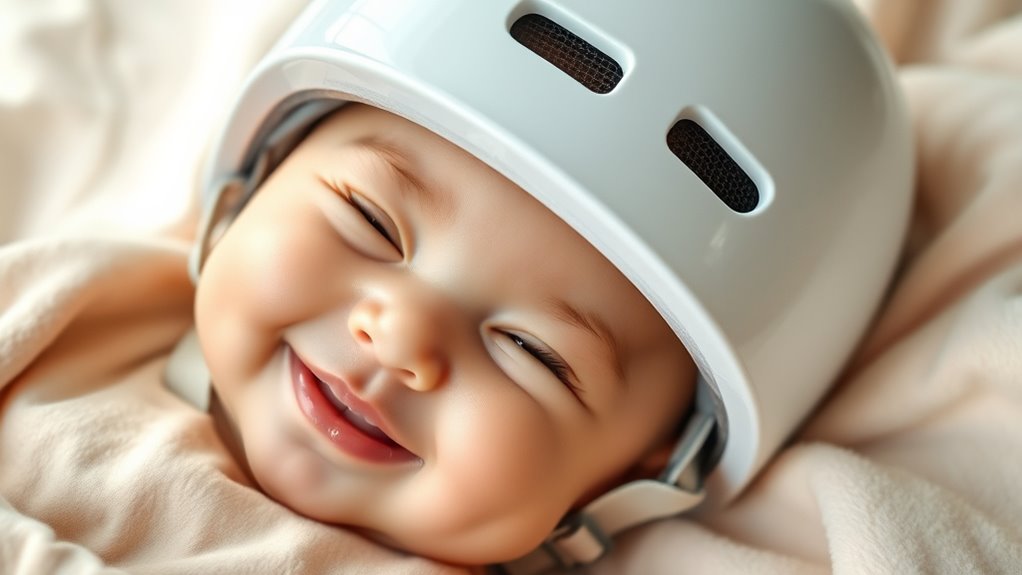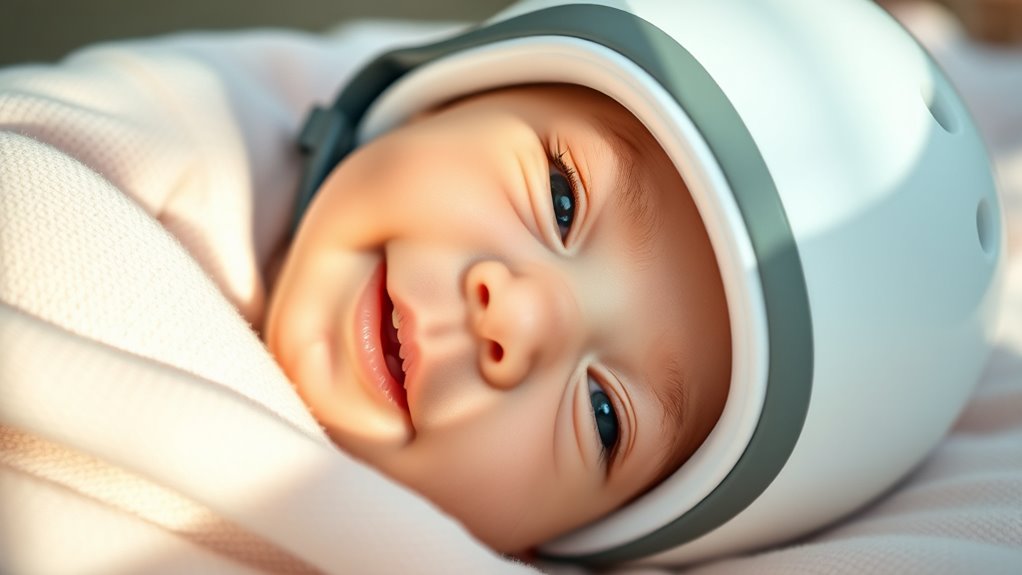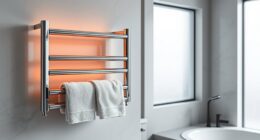Baby helmet therapy helps correct flat head syndrome and other skull deformities by guiding skull growth early in development. The helmets are custom-made from lightweight, durable materials and designed for daily wear, ensuring comfort and safety. They involve a snug fit with proper padding to prevent irritation, and the materials are breathable and easy to clean. If you want to understand how this treatment can support your child’s skull development, you’ll find useful details ahead.
Key Takeaways
- Helmet therapy corrects cranial deformities like flat head syndrome and plagiocephaly, especially effective when started early.
- Baby helmets are custom-molded from lightweight, breathable materials to ensure safety, comfort, and proper skull shaping.
- Proper fit and padding are essential to prevent skin irritation and ensure consistent, comfortable wear during daily use.
- The therapy’s success relies on timely initiation and severity of the deformity, with continuous monitoring by healthcare professionals.
- Regular cleaning and maintenance of the helmet are important to maintain hygiene and support effective skull development.

Have you ever wondered how a baby helmet can help correct your child’s head shape? If your baby has cranial deformities, such as flat head syndrome or plagiocephaly, a helmet can be an effective treatment. These deformities often occur when a baby spends too much time lying on their back, leading to uneven pressure on certain parts of the skull. The goal of helmet therapy is to gently shape the skull into a more typical form, promoting symmetrical growth as your child develops.
The success of helmet therapy depends on factors like the severity of the cranial deformity and how early you start treatment. When it comes to the helmets themselves, helmet materials are carefully chosen to guarantee safety, comfort, and effectiveness. Most helmets are made from lightweight, durable plastics that provide enough rigidity to influence skull growth without feeling heavy on your baby’s head. The inner lining is usually padded with soft foam or similar cushioning material, which helps prevent discomfort and skin irritation. This padding also allows the helmet to fit snugly without causing pressure points.
Design-wise, these helmets are custom-molded to your baby’s head, ensuring a perfect fit that addresses the specific areas needing correction. The process involves taking precise measurements or 3D scans of your child’s head, then crafting a helmet tailored to their unique shape. The helmet’s structure encourages growth in flatter or misshapen areas while slowing or redirecting growth in others. Because of the materials used, the helmet remains lightweight, making it easier for your baby to wear it for the recommended hours each day.
Ease of cleaning and durability are also important considerations. Most helmet materials are resistant to moisture and easy to clean, which helps keep your baby’s scalp healthy during therapy. Since the helmet is worn for several hours daily, comfort is paramount—so the materials are chosen to be breathable and non-irritating. You might worry about the helmet feeling uncomfortable or causing skin issues, but proper padding and high-quality helmet materials help prevent these problems.
Frequently Asked Questions
How Long Does Baby Helmet Therapy Typically Last?
You might wonder how long baby helmet therapy lasts. Typically, the helmet duration varies depending on your baby’s needs, but most children wear it for about 3 to 6 months. The therapy timeline involves regular check-ups with your healthcare provider to monitor progress and adjust the helmet as needed. Consistency is key, and your baby’s head shape should improve gradually during this period.
Are There Any Risks or Side Effects Involved?
Like a gentle breeze, helmet safety alleviates parental concerns about risks or side effects. Generally, baby helmet therapy is safe when monitored by your healthcare provider. Minor skin irritation might occur, but it’s usually manageable. Serious side effects are rare, so stay attentive and follow your doctor’s advice. Always ask questions to ensure your little one’s comfort and safety, giving you peace of mind during this important treatment.
Can Baby Helmet Therapy Be Combined With Other Treatments?
You might wonder if baby helmet therapy can be combined with other treatments. It’s common for parents to have concerns, and yes, alternative therapies like physical therapy or cranial osteopathy can often complement helmet therapy. However, you should always consult your child’s healthcare provider first. They can guarantee that combining treatments is safe and appropriate, helping you make the best decisions for your baby’s health and development.
How Early Should Treatment Begin for Best Results?
Imagine catching a gentle sunrise—early intervention in craniosynostosis diagnosis is just as essential. You should start treatment as soon as possible, ideally within the first few months of life, when your baby’s skull is still soft and malleable. Addressing parental concerns early helps guarantee the best results, guiding your little one’s growth like a skilled artist shaping a masterpiece, leading to ideal cranial development.
Is Helmet Therapy Effective for All Types of Skull Deformities?
You might wonder if helmet therapy works for all skull deformities. Helmet effectiveness varies depending on the type and severity of the skull deformity. It’s most effective for conditions like plagiocephaly and brachycephaly but may not fully correct more complex deformities. Consulting a specialist helps determine if helmet therapy suits your baby’s specific skull shape and guarantees you get the best possible outcome.
Conclusion
So, next time you think about avoiding a baby helmet, just remember how that tiny plastic shell is really a superhero cape in disguise. It’s funny—what seems like a bulky, awkward device actually helps shape your little one’s perfect head. Ironically, what you see as a hassle could be the best gift for their future confidence. Embrace the helmet—it’s like giving your baby a stylish, tiny hat that works miracles.









